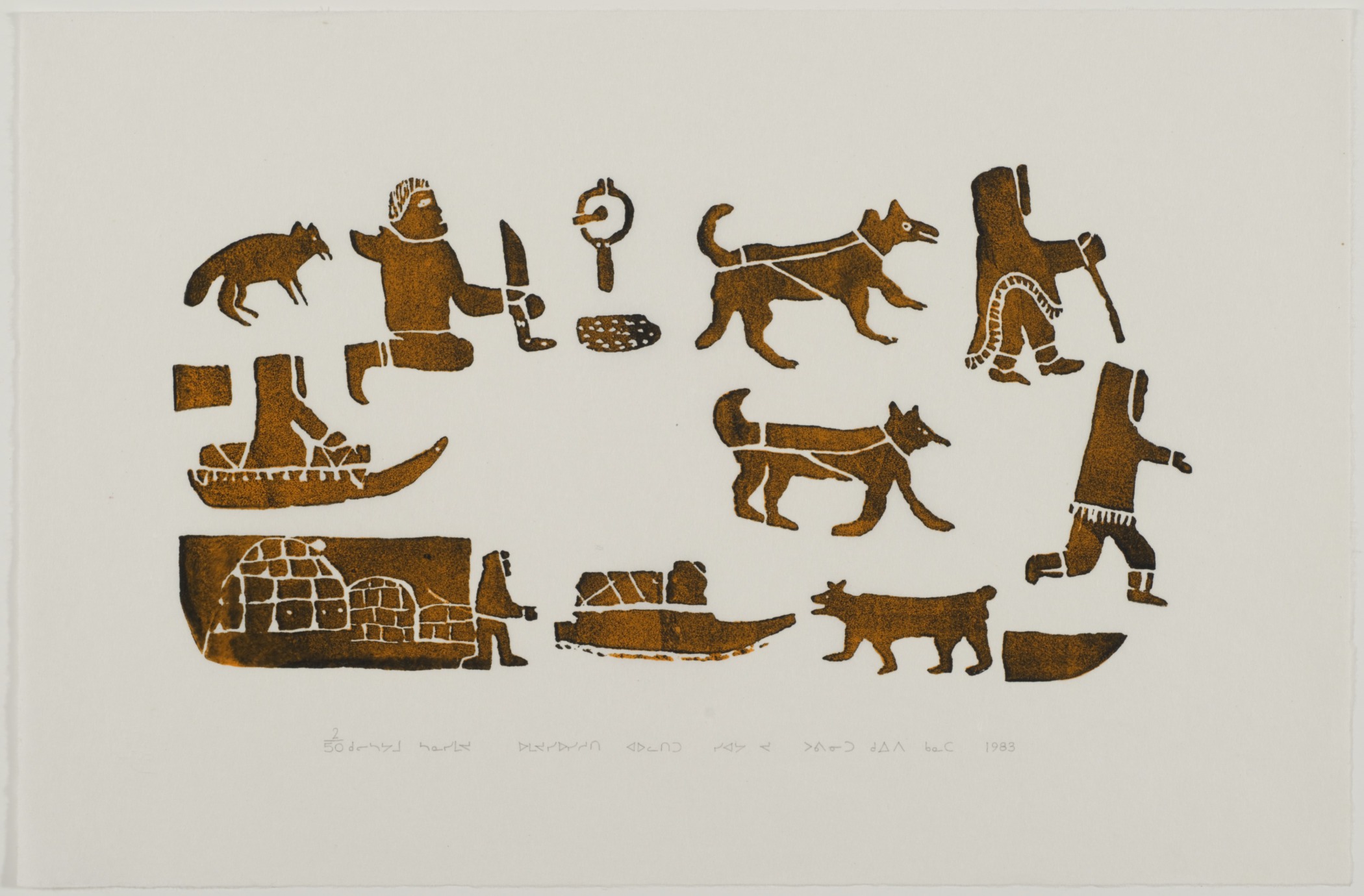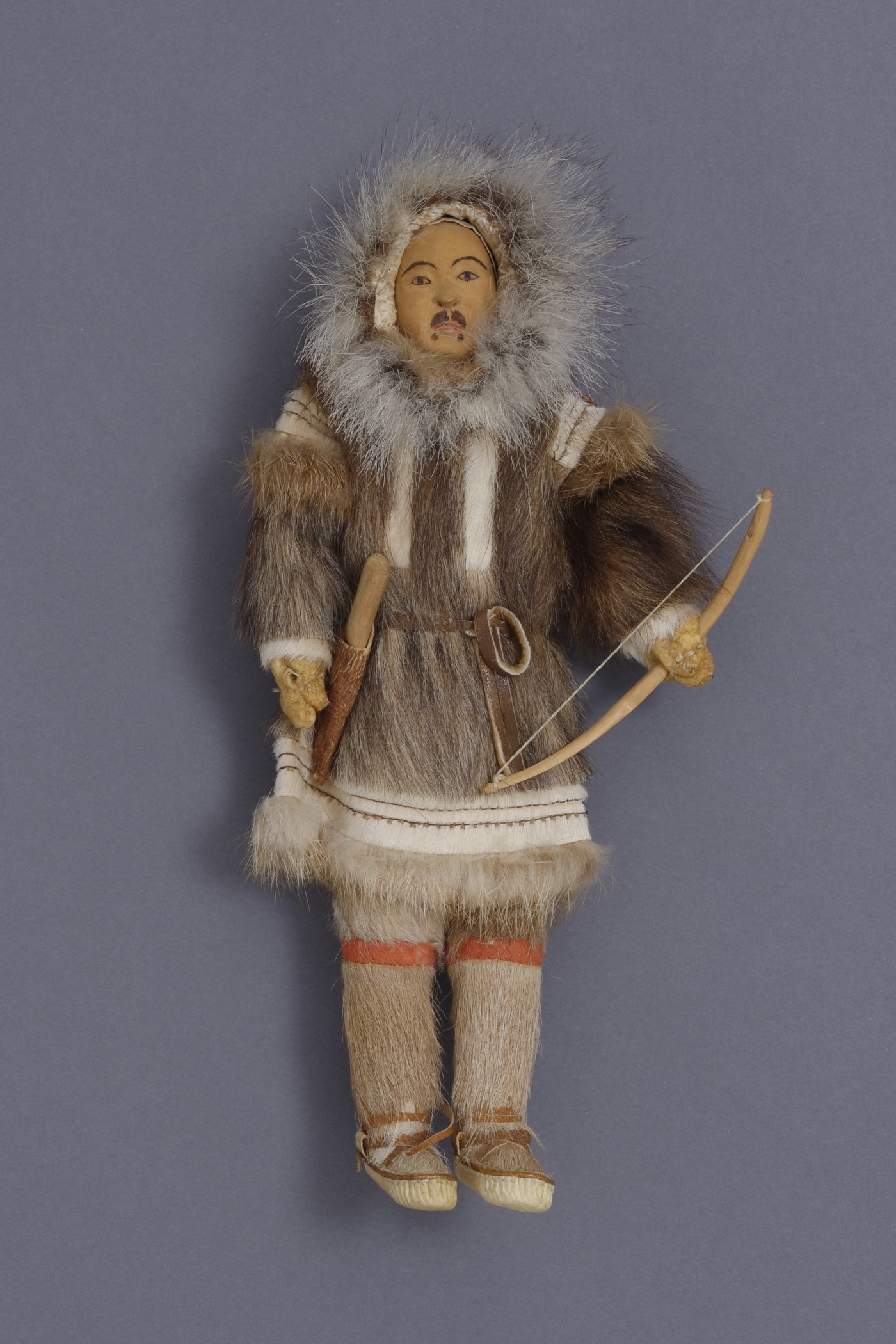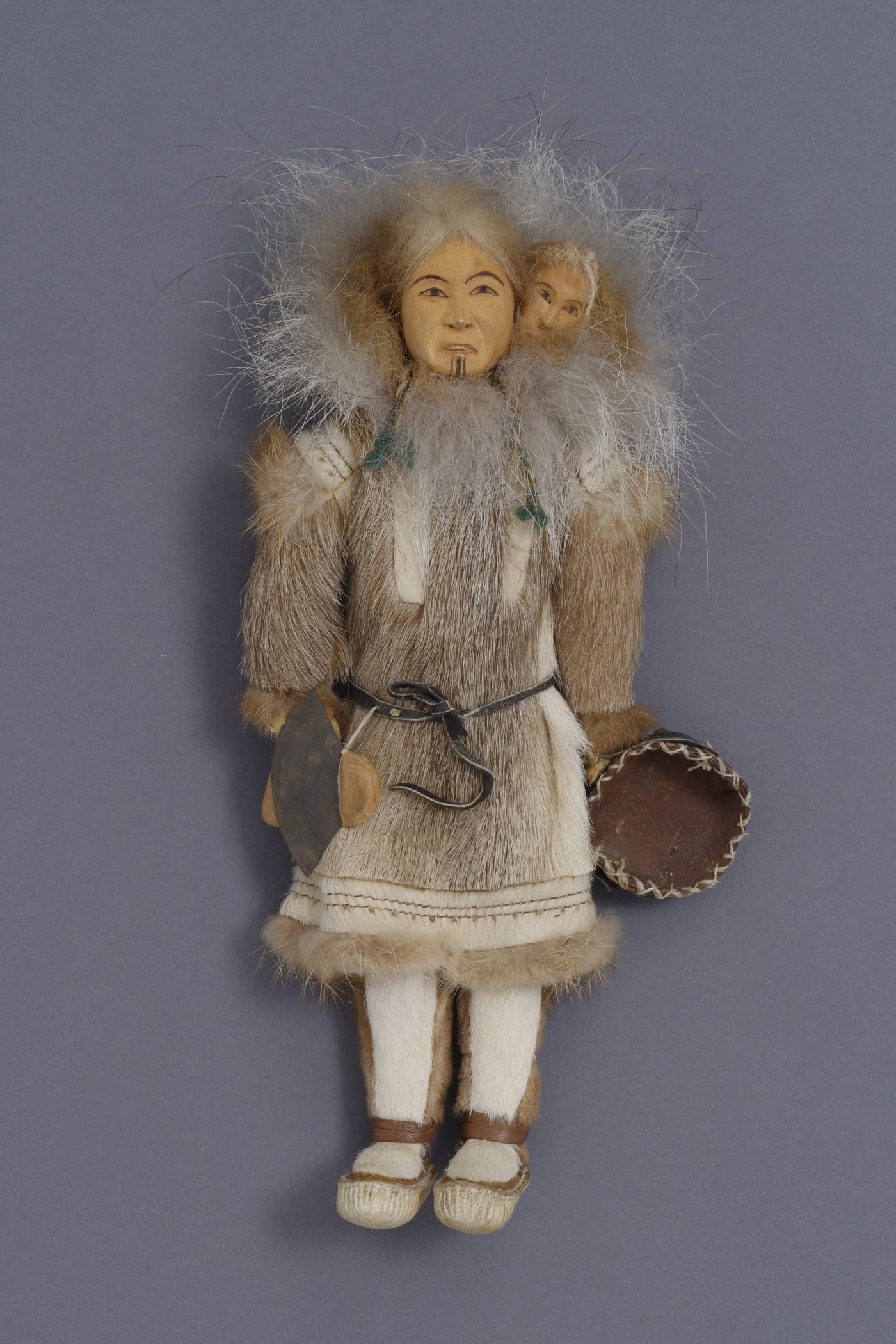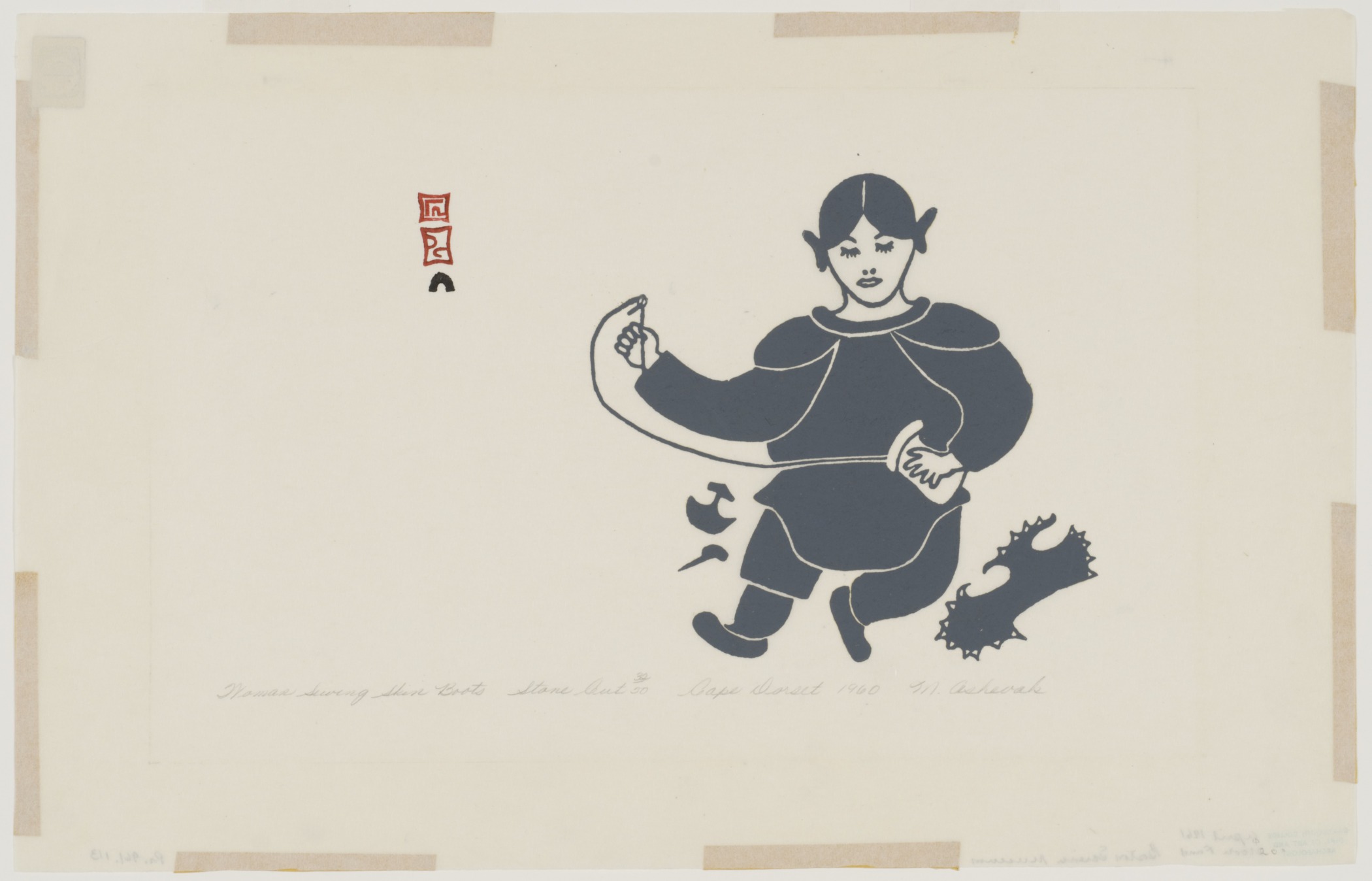Mary Ashevak Ezekiel, Canadian (Inuit), born 1932
Printer: Lukta Qiatsuk | Publisher: West Baffin Eskimo Cooperative
Woman Sewing Skin Boots
- 1960
- Stonecut print on paper, edition 32/50
- Sheet: 12 3/4 × 19 1/4 in.
Hood Museum of Art, Dartmouth College: Purchased through the Guernsey Center Moore 1904 Memorial Fund, PR.961.113
visibilityLook & DiscussMen’s and women’s roles in the Arctic were complementary. Men hunted animals for food and clothing, but women made the warm clothing essential for the hunters' survival. Many works of art honor the contributions of women in this region.
explore the object
The object on the floor to the sitter’s right is the unused piece of sealskin left over after cutting out the shapes for a pair of boots. The holes along the edges indicate that she stretched and dried the skin earlier by tying it to a rack. She is now in the process of sewing the bottom of the boot onto the upper part of the boot. She needs only a few tools, which she keeps nearby for the entire process: a needle and thread, a woman’s knife, or ulu, and an awl, a pointed tool for making holes in hides. The blank background of this print gives this task a timeless quality. It might also suggest that this young woman is sitting in the snow.
The woman is dressed traditionally in boots, leggings, and an amauti, or woman’s parka with a shaped bib in the front and back and a wide hood. Her downcast eyes show her attention to detail and her craftsmanship. She is calm and hardworking, qualities admired in Arctic.
This print is an example of a new 20th-century art form in the Arctic known as stonecut printing. The asymmetry of this image shows the influence of Japanese printmaking on Inuit printmakers. Like Japanese prints, Inuit prints credit the artist who drew the original image, the printmaker who chose where to place the image on the page and produced the edition of multiple prints, and the printmaking shop where the process took place. In this print, a symbol or “chop” identifying each contributor appears in the upper left corner. The top chop is the signature of the artist written in Inuktitut syllabics; the second is that of the printer; and the bottom chop, in the shape of an igloo, signifies the printmaking shop.
related objects
The Hood Museum of Art’s collection includes objects featured in this print.
Abraham Pov, Canadian (Inuit; Povungnituk [Puvirnituq] / Inukjuak), 1927–1994, Woman, 1982. Steatite stone, 13 3/4 × 5 7/8 × 6 11/16 in. Hood Museum of Art, Dartmouth College: Gift of Jane and Raphael Bernstein; 2011.64.35.
Tuthrak (Sophie) Nashalook, Iñupiaq, born 1880/1, ulu with a carved ivory handle depicting a bear, walrus and two seals, early 20th century. Ivory and steel, 5 1/8 × 8 1/4 × 13/16 in., Hood Museum of Art, Dartmouth College: Gift of Mrs. Levi Browning; 168.97.24526.
This sculpture (above left) shows a woman stretching a sealskin on a “D” frame, part of the process of preparing skin to be made into clothing and footwear. Notice the scalloped edges of the sealskin formed by lashing it to the frame.
The ulu (above right) is a woman’s knife, a tool with a semicircular blade for skinning animals and preparing hides.
Kitlinermiut (Copper Inuit), woman’s sewing awl with a round bone guard, collected 1953–62. Copper and bone, height: 3 15/16 in. Hood Museum of Art, Dartmouth College: Sherman P. and Anne L. Haight Arctic Collection; 168.94.24463.
Iñupiaq, ivory needle case with belt thong, collected 1905. Ivory and sealskin strip, height: 3 3/16 in. Hood Museum of Art, Dartmouth College: Bequest of Frank C. and Clara G. Churchill; 46.17.9678.
Canadian (Inuit), child’s summer boots, collected 1929–30. Sealskin and sinew, 6 1/4 × 1 7/8 × 4 15/16 in. Hood Museum of Art, Dartmouth College: Gift of Robert O. Fernald, Class of 1936; 158.25.14217.
An awl such as this would have been used to pierce holes in hide prior to sewing. Historically, awls were made of copper, stone, or bone. Today, most people use steel awls.
In the past, clothing was made with needles like these, made of ivory or bone, and thread made from animal sinew. Today, seamstresses use steel needles and artificial sinew or waxed dental floss for thread.
These sealskin boots (the fur on the outside has been scraped away) were intended for a child and used in late spring and early summer. Despite the advent of rubber galoshes, sealskin boots remain common in the Alaskan and Canadian Arctic, as does their detailed sewing process. To avoid penetrating two layers of hide in any one place, boot seamstresses begin with a running stitch that dips into the inside skin without piercing it completely. Pinching an extra layer of the sole, the seamstress then pulls together the now-tight seam with a second threading to create the double-fold waterproof stitch. The bleached white sealskin and the decorative scalloped edge at the top indicate that these boots were made for special occasions, like going to church. For that reason, they are sometimes called church or Sunday boots.
Activity: Stonecut Printmaking Project
This activity mimics the process and look of stonecut printing.
learn more
In this series of videos Inuit scholar Heather Igloliorte shares information about this print, some of the related objects and the tradition of sewing sealskin boots.

![Abraham Pov, Canadian (Inuit; Povungnituk [Puvirnituq] / Inukjuak), 1927–1994, Woman, 1982. Steatite stone, 13 3/4 × 5 7/8 × 6 11/16 in. Hood Museum of Art, Dartmouth College: Gift of Jane and Raphael Bernstein; 2011.64.35.](https://images.squarespace-cdn.com/content/v1/59b8401712abd96b1209bc34/1509048666134-YUEX9RG22OBQUIZOFA81/Object+87+Woman.jpg)








